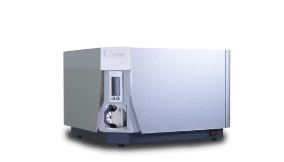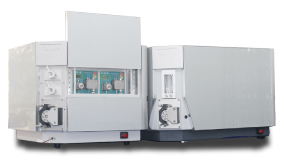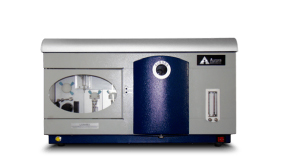
Atomic Fluorescence Spectroscopy Analysers
Atomic Fluorescence Spectroscopy Analysers
Atomic fluorescence spectroscopy (also known as atomic spectrofluorometry or atomic fluorimetry) is a technique used in biochemical, medical, and chemical applications that require very high sensitivity as well as precision and accuracy. An atomic fluorescence spectrometer is capable of measuring samples containing both hydride-forming elements and Mercury at a parts per trillion (ppt) level using the unique vapour hydride generator. The high sensitivity and reliability of Aurora’s series of Atomic Fluorescence Spectrometers is ideal for elemental analysis in a variety of research sectors.

Atomic Fluorescence Theory
The technique behind atomic fluorescence spectroscopy is similar to atomic absorption spectrometry in that a sample absorbs light at a particular wavelength to promote its electrons from its ground electronic state into an excited state. From this excited electronic state, the electron drops down to a lower electronic state emitting a photon with a specific wavelength in the process. By measuring the intensity of the emitted light at particular frequencies, it is possible to determine the concentration of the element in question via atomic fluorescence spectrometry.
Applications
- Public health and disease control
- Metallurgical and geological industries
- Petrochemical industries
- Pharmaceutical industries
- Clinical diagnostics
- Agriculture
- Environmental monitoring
Vapour Hydride Generator
The vapour hydride generater ensures a sensitive measurement of hydride forming elements, of which mercury detection is the most common application. Mercury analysis is a critical component of several industries, including food and water safety, agriculture and environmental monitoring. Samples must be digested prior to analysis to ensure for accurate analyte measurement. The sample is then atomized, and any free atoms are excited by ultraviolet light emitted by a hollow cathode lamp. Consequently, the excited atoms re-radiate the absorbed energy at particular frequencies which allows for quantification and analysis. This technique is sensitive and linear over a wide range of concentrations. Providing enhanced sensitivities, reduced interferences, and extremely low detection limits for the determination of sub-trace levels of hydride-forming metals, Aurora’s revolutionary all-in-one design allows for optimum performances for any application requiring either mercury detection or analysis of any hydride forming element. Aurora’s atomic fluorescence spectroscopy analyzers boast unbeatable sensitivity and the best technique to detect and analyze hydride-forming elements. The analyzers offer a solution that is more sensitive, cost-effective, and reliable than traditional atomic fluorescence spectrometry techniques.
Frequently Asked Questions
LUMINA Atomic Fluorescence Spectrometers
The LUMINA 3500/3600 Atomic Fluorescence Spectrometer is ideal for elemental analysis in various research sectors, including; environmental, agricultural, geological, metallurgical, pharmaceutical, clinical and petrochemical. It is capable of acting as a mercury analyzer while also carrying out elemental analysis of all hydride-forming elements.
- Sub-trace level detection limits for mercury and hydride-forming elements
- Linear dynamic range of 10³
- Covered optical design
- Dual-channel simultaneous measurement
- All-in-one mixing manifold, low dead volume, high efficiency, double gas/liquid separator design
- Automatic Ar-H2 flame ignition
- Integrated exhaust system
- Vapor / Hydride generator
- Revolutionary gas/liquid separator
- Reaction/Mixing manifold
- Covered optical design
- Dual Channel simultaneous analyses
- Integrated exhaust system
- User-friendly, Windows-based software
- XYZ autosampler (optional)
- Can be used as a mercury analyzer

LUMINA 3500 Atomic Fluorescence Spectrometer
The LUMINA 3500 Atomic Fluorescence Spectrometer provides elemental analysis solutions for sub trace detection of hydride-forming elements. The unique vapour/hydride generator provides enhanced sensitivities and reduced interferences for parts per trillion (ppt) detection of Mercury (Hg), Arsenic (As), Cadmium (Cd), Zinc (Zn), Bismuth (Bi), Selenium (Se), Tellurium (Te), Antimony (Sb), Tin (Sn), Germanium (Ge), and Lead (Pb).

LC-LUMINA 3600 Atomic Fluorescence Spectrometer
The LC-LUMINA 3600 (Integrated High Pressure Liquid Chromatography – Atomic Fluorescence Spectrometer 3500) can be used for the application of speciation analysis, or quantifying ultra-trace concentrations of different molecular versions of the same compound.
The LC-LUMINA 3600 finds use for environmental applications such as precise quantifications of inorganic and organic forms of Mercury (Hg) and other hydride forming elements from biological samples. This is because elements in different oxidation states exhibit different adsorption tendencies, thereby enabling speciation analysis using an integrated HPLC-AFS system.

LUMINA 3400 Atomic Fluorescence Spectrometer
The LUMINA 3400 Atomic Fluorescence Spectrometer utilizes precise syringe pumps to provide sub trace detection and elemental analysis of hydride-forming elements. The unique vapour/hydride generator provides enhanced sensitivities and reduced interferences for parts per trillion (ppt) detection of Mercury (Hg), Arsenic (As), Cadmium (Cd), Zinc (Zn), Bismuth (Bi), Selenium (Se), Tellurium (Te), Antimony (Sb), Tin (Sn), Germanium (Ge), and Lead (Pb).
Need more information / Questions?
Need more information / Questions?
Please contact us by phone or email:
Freephone 0800 724 633
Or use the contact form below:
A to Z Product Listing
A to Z Product Listing
Copyright © 2025, Scienze. All rights reserved.
